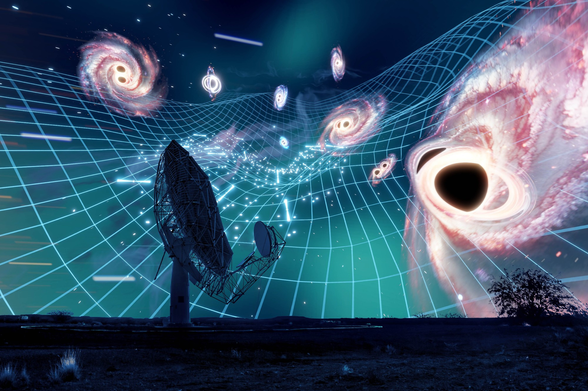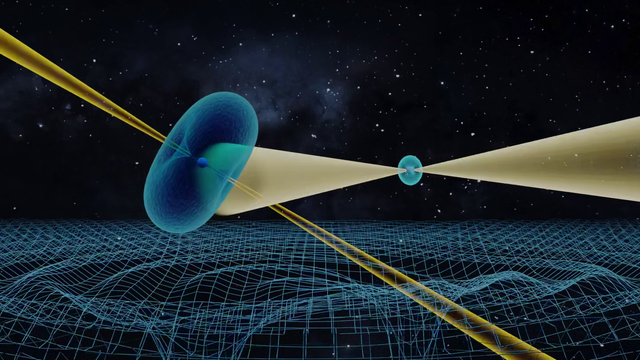Recent searches
Search options
#radioastronomy
Are We Missing the Cosmic Signal?
Radio-based searches for alien intelligence have improved—but are we even listening the right way? This study reviews how far we've come—and what we still don’t know. https://papers.ssrn.com/sol3/Delivery.cfm?abstractid=4708832
#RadioAstronomy #PonderLab #AliensWeek
Was reading some online slides and came across this excellent #RadioAstronomy image from the NRAO/AUI/NSF.
The terrestrial portion is optical wavelengths. Above this is radio wavelengths.
Those are not stars. They are radio sources.
They're supermassive black holes in the centres of galaxies.
The sky portion of this image was taken by the now fallen 300-ft radio telescope, pictured here as the largest dish between the smaller dishes.
If you had a radio wavelength-detecting eye that was 300 feet in diameter, this is how the sky would look to you.
A sea sprinkled with ancient light.
You can download this image, and use it from this link from the NRAO site here: https://www.nrao.edu/archives/items/show/33605
Be sure to attribute properly and just copy my alt-text.
You can also read the paper here: https://articles.adsabs.harvard.edu/pdf/1994AJ....107.1829C
Want to wake up every morning and have this as your view?
Well, now's your chance!
https://jobs.csiro.au/job/Parkes%2C-NSW-Observatory-Manager-Parkes-Observatory/1060694666/
Best* telescope in the world!
* according to me, and many others, and you know it is, so let's not argue about this, kthxbai
(pic by me)
HT Mark Cheung (from CSIRO)
Milestone reached! We've finally determined the intensity of the Wow! Signal—one of its long-standing mysteries. Previous estimates were 54 Jy or 212 Jy. This new finding is just one of the key insights we’ll present in our upcoming paper, #AreciboWow II. #Astronomy #RadioAstronomy #SETI
Barbara A. Williams, radio #astronomer
1st African-American woman to earn PhD in #astronomy, #UniversityofMaryland in 1981
expanded our knowledge of compact #galaxy clusters, galactic evolution
#BlackHistoryMonth #WomenInSTEM #histsci #radioastronomy #astrophysics
photo courtesy S. Williams, Astronomers of the African Diaspora
Does a Radome Affect Radio? - Not too far away from where this is being written is one of Uncle Sam’s NATO outpo... - https://hackaday.com/2025/01/25/does-a-radome-affect-radio/ #radioastronomy #geodesicdome #radiohacks #radome
Si te interesa la ingenería de sistemas y/o la astronomía, puede que te interese asistir al webinar que voy a dar en unos 5 minutos sobre desafíos de ingeniería de sistemas por el Wideband Sensitivity Upgrade (Actualización de Sensibilidad de Banda Ancha).
Zoom: https://incose-org.zoom.us/j/85248093758?pwd=KbAEckd3I9Hi95omkAcV62TaBcvFO0.1
Detalles: https://www.linkedin.com/events/7284692059783868416/attendees/
Cool, and thanks, @ast_spacemobile. This is a good start. But what about about radio astronomy? And what about collision risk mitigation?
https://www.pcmag.com/news/ast-spacemobiles-large-satellites-to-roll-and-tilt-to-prevent-astronomy
[2/3] It's not showing how remote viewing can explain #UFOs. It's not showing remote viewing at all, so far.
Post #Newton, #science & #philosophical thought require #math & other #technologies that extend our #human senses & capabilities — #radioastronomy for example. These methods reach beyond our #biases, #intuitions & other limitations.
The show asks us to be #skeptical of official agendas, but then clouds its own #agenda. It knows a few things, but does it reveal hard #truths about #UFOs?
EVERYONE
The SKAO has released some short video of one of the SKA-Low stations (located in Australia) making a pulsar detection.
The SKA won’t be finished until around 2030s but stations will switch on so we’re heading into the early data collection stages.
If you’ve never heard of the SKA, it’s a new instrument being built in Australia and South Africa — and will be the most powerful radio telescope on our planet.
It’s going to change our view of the Universe, and has been decades in the making.
Read more: https://www.spaceaustralia.com/feature/road-leads-square-kilometre-array
The 25m Dwingeloo radio telescope (owned by ASTRON) has been operating since '50s. Recently, it has been used more by amateurs and pro-am radio astronomers.
Excitingly, they picked up the Voyager 1 signal.
Voyager 1 is ~25 billion km away! (~4 x Pluto distance)
Why this is neat?
Well, the Voyagers are so far away (human's furthest objects) that we need the biggest telescopes in the world (the Deep Space Network) to normally communicate with them. Those are big 70m dishes, so much larger gain.
A 25m dish, and the work of amateurs is a really nice story!
And to give you a scale of the signal power .... the signal from your home wi-fi is billions of times stronger (I think ~10 billion IIRC) than the signal Earth receives from Voyager spacecrafts. It's incredibly feeble, so detecting it is a big feat!
Well done to this team!
https://www.camras.nl/en/blog/2024/dwingeloo-telescope-receives-signals-from-voyager-1/
More exciting, unexplained science!
An emerging class of objects in #RadioAstronomy, mostly discovered in the last few years, still can't be explained.
Now, two new multi-wavelength studies might have answers.
Wrote about both these Aussie astronomy cases, and how they might be giving us those additional clues, to narrow in on what we are seeing.
Are these an entirely new object all together? OR, do we need to re-think our physics? Both scenarios are fascinating.
My next piece for #SpaceAustralia:
https://www.spaceaustralia.com/feature/multi-wavelength-views-new-galactic-radio-astronomy-mysteries
N. Hurley-Walker /MWA / Curtin / ICRAR
Some exciting results!
Using MeerKAT (super sensitive telescope array) the MeerKAT Pulsar Timing Array (MPTA) team have also found supporting evidence (with their assumptions and models) of the gravitational wave background (GWB) that other Pulsar Timing Arrays (PTAs) announced last year. This is further independent verification!
The Universe rattles!
I had a chat with Dr. Matt Miles from Swinburne Uni / OzGrav about his lead-author paper and results: https://www.spaceaustralia.com/feature/mpta-finds-evidence-gravitational-wave-background
But the fun doesn't stop there! An additional paper, co-authored by Rowina Nathan, used the MPTA data to make the most detailed map of the GWB, and found an intriguing anisotropy (though, statistically, could be insignificant). If it turns out to be true it shows the GWB is not isotropic, and we could be seeing a unique system or some unknown cosmology. Rowina wrote a piece in #SpaceAustralia about this too: https://www.spaceaustralia.com/feature/mapping-gravitational-wave-universe
Very cool science that take pulsars and turn the Galaxy into a detector.
C. Knox/Swinburne/OzGrav/SARAO
1 in 100 billion! (well, so far ....)
There is one, and ONLY one of these systems we know about. It features two neutron stars, both pulsars. In even better news, both of these pulsar beams shine in our direction - so we can study the light of one as it passes through the powerful magnetic field of the other.
That's what Dr Marcus Lower from Swinburne University of Technology and his team did - they used the extremely sensitive MeerKAT telescope in South Africa to study the light, and polarization of one pulsar's beam as it passed through the magnetic field of the other.
This is extreme astrophysics at its best.
There is very much likely more double pulsars out there, but maybe only one beams at us, or none beam at us.
So, this is the only one we have so far ....
My latest for #SpaceAustralia
https://www.spaceaustralia.com/feature/unveiling-extreme-physics-galaxys-only-double-pulsar-system
M. Kramer/MPIfR
#Astronomy, #satellites, and #Project2025: what's in store for FCC licensing of satellites in a 2nd Trump Administration?
According to AIP Science Policy News, and referencing @brendancarrfcc, it's not good.
https://ww2.aip.org/fyi/project-2025-outlines-possible-future-for-science-agencies
https://www.mitre.org/news-insights/news-release/mitre-led-team-develop-radio-dynamic-zone-spectrum-sharing-research
A MITRE-led team of spectrum engineers, academics, and radio astronomy researchers from across the country will develop and conduct dynamic spectrum sharing experiments following a $10.5 million cooperative agreement funded by the National Science Foundation (NSF) National Radio Dynamic Zones program.







